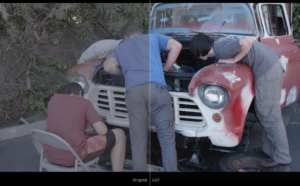Archive for February, 2017
 Shooting In log Makes Sense For Most Shooters
Shooting In log Makes Sense For Most Shooters
We all know that shooting in log can improve exposure latitude and dynamic range. In short, log capture allows us to record more professional-looking images, as the brightest highlights in sun-dappled scenes, for example, may often be accommodated without clipping or loss of detail.
Practically, shooting in log may also mean utilizing less fill light, which can be helpful on low-budget run-and-gun style productions. I always try to reduce the amount of gear in general on a set; and shooting in log can help reduce the grip and lighting complement substantially – a good thing in my opinion.
Remember more gear = less work.
Giving you an idea of how I work in log, when shooting with the VariCam LT, for example, I assign Y-Get to user button 1. Placing the EVF cross-hairs over the brightest part of a scene, with the iris adjusted to 69 IRE, the camera recording V-Log will accommodate 3-4 stops of additional latitude before clipping or a noticeable loss of highlight detail. Setting exposure in this way is simple and effective, and eliminates the need for external exposure meters and pricey reference monitors.
While shooting in log makes sense for most shooters, broadcast news and some non-fiction shooters may find the hassle and inconvenience of working with LUTs not be worth it, or even possible, given the tight time constraints and lack of serious post-production in most news and public affairs programming.

This scene captured in log is shown with and without a LUT applied. Despite the advantages of shooting in log, some producers may see working with LUTs as a hassle and an inconvenience.